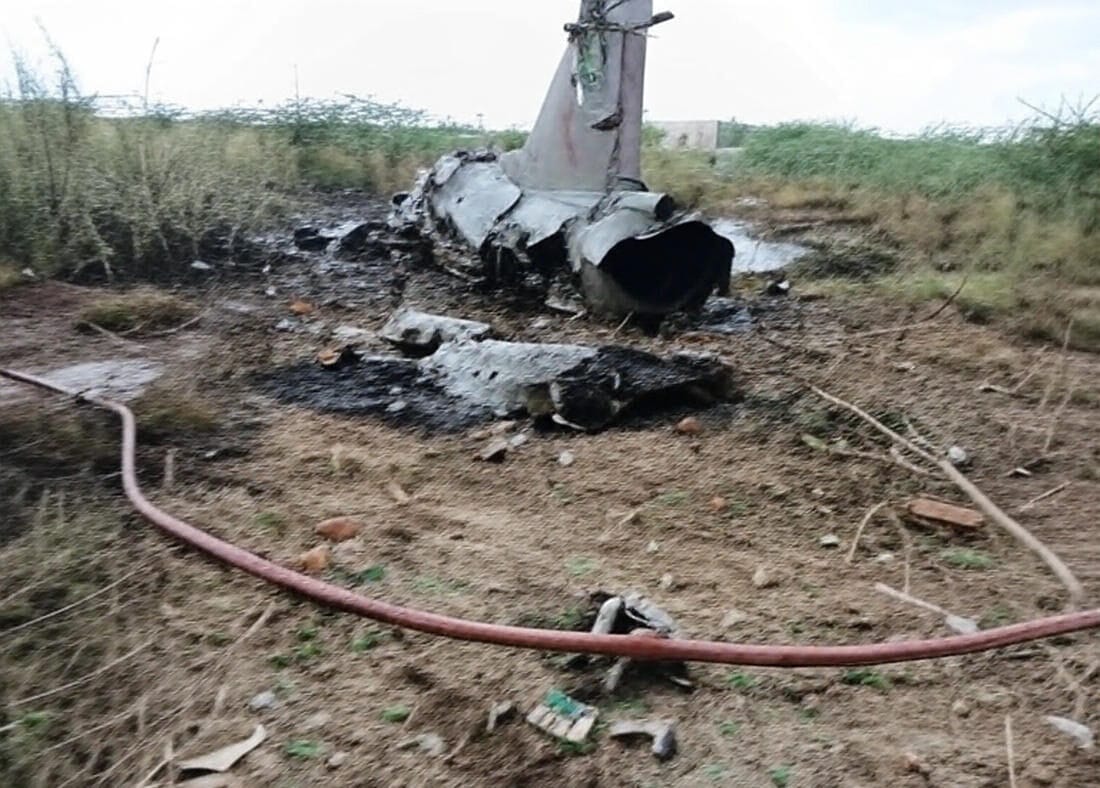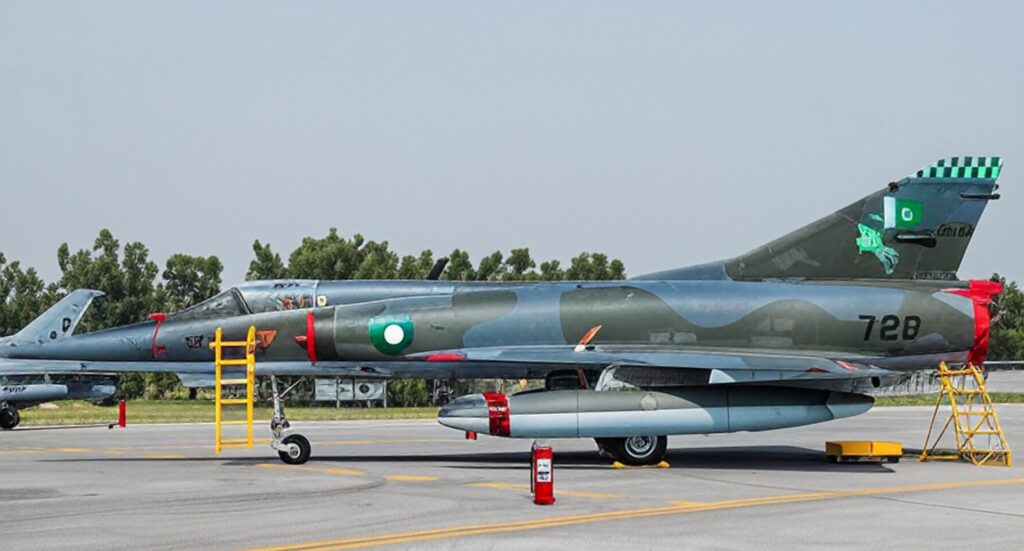
Sargodha, Pakistan – September 10, 2025
On September 9, 2025, a PAF Mirage 5 ROSE III fighter jet crashed during a routine training mission near 104 Chak, approximately 10-15 kilometers from Sargodha, Punjab. This incident, attributed to a suspected mid-air stall, has reignited concerns about the safety and reliability of the PAF’s aging Mirage fleet. As investigations unfold, this article explores the crash details, historical context, and implications for Pakistan’s air defense strategy, optimized for readers seeking comprehensive insights into this developing story.
Incident Overview
The Mirage 5 ROSE III, operated by the No. 27 Squadron “Zarrars” of the 32nd Tactical Attack Wing, was conducting a standard training sortie when it encountered difficulties. Preliminary reports suggest a mid-air stall, a critical condition where the aircraft loses lift due to disrupted airflow, leading to an uncontrolled descent. The jet crashed in fields near Sargodha, a key military hub housing PAF Base Mushaf. Emergency response teams, including Rescue 1122 and military personnel, secured the site, and a board of inquiry was promptly established to investigate the cause.
Key Details of the Crash
- Location: 104 Chak, 10-15 km from Sargodha, Punjab.
- Aircraft: Mirage 5 ROSE III, a modernized variant of the 1960s-era Dassault Mirage 5.
- Cause: Suspected mid-air stall; investigation ongoing.
- Casualties: No reported civilian casualties; pilot’s status unconfirmed.
- Response: Area cordoned off, emergency teams deployed.
The pilot’s condition remains unclear, with conflicting reports suggesting either a successful ejection or injuries requiring hospitalization. The absence of ground casualties is a relief, given the crash’s proximity to rural settlements.
Historical Context of PAF Mirage Crashes

The Mirage 5, a cornerstone of the PAF since the 1970s, has been upgraded under the Retrofit of Strike Element (ROSE) program to enhance its avionics, radar, and ground-attack capabilities. Despite these upgrades, the aircraft’s aging airframe and complex flight dynamics have led to recurring accidents. Since 2012, at least 15 Mirage 5 jets have crashed, resulting in the loss of nine pilots, earning the aircraft the grim nickname “widow maker” among aviation circles.
Recent PAF Incidents
- April 2025, Vehari: A Mirage V ROSE crashed during a training mission; both pilots ejected safely.
- 2023, Sonmiani: A Mirage 5 crashed during a test flight, with the pilot surviving.
- 2020, Karachi: A Mirage III crash claimed one pilot’s life during a routine exercise.
These incidents highlight ongoing challenges with the Mirage fleet, which remains operational despite the PAF’s gradual shift to modern platforms like the JF-17 Thunder, developed in collaboration with China.
Sargodha’s Strategic Importance
Sargodha, located in Punjab’s heartland, is home to PAF Base Mushaf, a critical hub for Pakistan’s Central Air Command. The base hosts a variety of aircraft, including Mirage 5s, F-16 Fighting Falcons, and JF-17 Thunders, and has played a pivotal role in past conflicts, notably the 1965 Indo-Pakistani War. Its proximity to major urban centers and strategic airspace makes it a focal point for PAF operations, amplifying the significance of this crash.
Why Sargodha Matters
- Strategic Hub: Hosts key PAF squadrons and training facilities.
- Historical Significance: Played a central role in Pakistan’s air defense during regional conflicts.
- Current Role: Supports advanced fighter jet operations and pilot training.
Investigation and Public Reaction
The PAF has yet to release an official statement on the pilot’s condition or the crash’s precise cause, fueling speculation on platforms like X. Some users have suggested external factors, such as electronic warfare interference, though these claims lack substantiation. The board of inquiry will analyze flight data, pilot testimony, and wreckage to determine whether mechanical failure, human error, or environmental factors contributed to the incident.
Public sentiment, as observed on social media, reflects concern over the PAF’s reliance on aging aircraft. Calls for accelerated fleet modernization have grown louder, with many urging investment in newer, more reliable platforms to enhance pilot safety and operational effectiveness.
Implications for PAF’s Future
The crash underscores the challenges of maintaining a fleet of aging aircraft, even with upgrades like Project ROSE, managed at the Pakistan Aeronautical Complex in Kamra. The Mirage 5’s design, rooted in 1960s technology, struggles to meet modern demands, particularly in high-intensity training scenarios. As the PAF transitions to the JF-17 Thunder and explores fifth-generation fighters, incidents like this highlight the urgency of phasing out legacy platforms.
Modernization Efforts
- JF-17 Thunder: A cost-effective, multirole fighter replacing older Mirage variants.
- Project Azm: Pakistan’s initiative to develop a fifth-generation stealth fighter.
- Maintenance Overhauls: Enhanced protocols to address mechanical failures in legacy fleets.
The investigation’s findings will likely influence decisions on the Mirage fleet’s operational scope and accelerate modernization timelines. Pilot safety remains a priority, with the PAF facing pressure to balance budget constraints against the need for reliable aircraft.
Broader Context of Aviation Safety

Globally, military aviation faces challenges with aging fleets, as seen in similar incidents involving legacy aircraft like the U.S. Air Force’s F-4 Phantoms or India’s MiG-21s. The PAF’s experience mirrors these trends, where budget limitations and operational demands necessitate prolonged use of older platforms. This crash may prompt renewed discussions on international cooperation for technology transfers or joint ventures to bolster Pakistan’s air capabilities.
Steps Forward
- Enhanced Training: Focus on stall recovery and emergency procedures.
- Fleet Upgrades: Prioritize newer aircraft to reduce reliance on Mirages.
- Transparency: Timely updates to address public concerns and speculation.
Conclusion
The September 9, 2025, Mirage 5 ROSE III crash near Sargodha is a stark reminder of the risks associated with operating aging military aircraft. As the PAF investigates the incident, the focus remains on ensuring pilot safety, enhancing maintenance protocols, and accelerating fleet modernization. Sargodha’s strategic importance and the PAF’s storied history amplify the need for swift action to prevent future tragedies. For the latest updates, follow credible news outlets or official PAF statements.
Sources: SSB Crack, ProPakistani, Indian Defence Research Wing, Avions Legendaires
Keywords: PAF Mirage 5 crash, Sargodha airbase, Pakistan Air Force, Mirage 5 ROSE III, aircraft safety, JF-17 Thunder, military aviation





